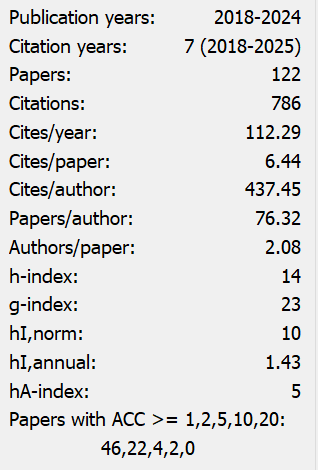Factors Influencing Secretarial Personnel's Willingness to Remain in the Information Cocoon Based on Push-Pull-Mooring (PPM) Theory
Abstract
The information cocoon effect is becoming increasingly prominent. Secretarial positions, which serve as crucial nodes for organizational information acquisition, processing, and dissemination, are susceptible to being trapped in closed information environments. Based on the Push-Pull-Mooring (PPM) theoretical framework, this study constructs a theoretical model incorporating information similarity, social influence, and decision-making rationality as push factors; information overload, perceived active control of information, and algorithmic influence as pull factors; and information selection tendency and behavioral rigidity as mooring factors. We design an indicator system for each level of the model and empirically test it through a questionnaire survey of secretarial staff. The study reveals the multi-dimensional mechanisms underlying secretarial personnel’s willingness to remain in information cocoons. It also provides recommendations from the perspectives of secretarial staff, platform algorithms, and the information supply side to help secretaries break out of the information cocoon predicament and enhance their information work performance.
References
[2] Sunstein, C. R. (2006). Infotopia: How many minds produce knowledge. Oxford University Press. https://doi.org/10.1093/oso/9780195189285.001.0001
[3] Peng, L. (2020). Factors leading to information cocoon and ‘breaking the cocoon’ path. Journalism Journal, 2020(01), 30–38+73.
[4] Zhang, Y., Zhuang, B., Li, Q., & Zhu, Q. (2023). Homogenization dilemma: Conceptual analysis and theoretical framework of the information cocoon. Journal of Library Science in China, 49(03), 107–122.
[5] Shi, A. (2019). Analysis of the information cocoon effect from a cybernetic perspective. Journalism Frontier, 2019(1), 77–78.
[6] Zhang, L. (2017). The reality and future imagination of intelligent media — Changes in the news field as an example. Journal of Zhengzhou University (Philosophy and Social Sciences), 50(4), 146–149.
[7] Ravenstein, E. G. (1889). The laws of migration. Journal of the Royal Statistical Society, 52(2), 241–305. https://doi.org/10.2307/2979333
[8] Moon, B. (1995). Paradigms in migration research: Exploring ‘moorings’ as a schema. Progress in Human Geography, 19(4), 504–524. https://doi.org/10.1177/030913259501900404
[9] Hou, A. C. Y., Chern, C. C., Chen, H. G., et al. (2011). ‘Migrating to a new virtual world’: Exploring MMORPG switching through human migration theory. Computers in Human Behavior, 27(5), 1892–1903. https://doi.org/10.1016/j.chb.2011.04.013
[10] Deng, X., Li, Y., & Xiong, W. (2024). Emotional exhaustion, group identity, and social network maintenance — A study on mobile short video platform user switching intentions based on the push-pull-mooring migration theory model. Journalism Journal, 2024(04), 61–75.
[11] Zhang, Y., & Li, Q. (2022). A study of factors influencing online users’ willingness to remain in the information cocoon based on PPM theory. Modern Information, 42(04), 52–61.
[12] McPherson, M., Smith-Lovin, L., & Cook, J. M. (2001). Birds of a feather: Homophily in social networks. Annual Review of Sociology, 27(1), 415–444. https://doi.org/10.1146/annurev.soc.27.1.415
[13] Zhang, H. (2021). Research on the conceptual framework of the formation mechanism of network users’ information cocoon. Information Theory and Practice, 2021(Online).
[14] Lin, H. F. (2008). Determinants of successful virtual communities: Contributions from system characteristics and social factors. Information & Management, 45(8), 522–527. https://doi.org/10.1016/j.im.2008.08.002
[15] Wang, Y., & Zhang, M. (2023). Study on factors and associated paths of online users’ information cocoon. Modern Information, 43(11), 158–167.
[16] Hoffman, D. L., & Novak, T. P. (1996). Marketing in hypermedia computer-mediated environments: Conceptual foundations. Journal of Marketing, 60(3), 50–68. https://doi.org/10.1177/002224299606000304
[17] Ghani, J. A., & Deshpande, S. P. (2010). Task characteristics and the experience of optimal flow in human-computer interaction. Journal of Psychology, 128(4), 381–391.
[18] Chen, J. (2023). The impact of information cocoon on college students and strategies for breaking the cocoon. Computer Knowledge and Technology, 19(27), 107–109.
[19] Wang, R., Feng, B., & Li, M. (2017). Mechanism of selective attention and influencing factors. Psychology Technology and Application, 5(9), 567–573.
[20] Zhang, Y., & Zhao, Y. (2021). Analysis of the causes of information cocoon in a mobile reading environment. Modern Information, 41(10), 3–11. https://doi.org/10.1155/2021/6617286
[21] Ye, C., & Potter, R. (2011). The role of habit in post-adoption switching of personal information technologies: An empirical investigation. Communications of the Association for Information Systems, 28(1), 585–610. https://doi.org/10.17705/1CAIS.02835


This work is licensed under a Creative Commons Attribution 4.0 International License.
Copyright for this article is retained by the author(s), with first publication rights granted to the journal.
This is an open-access article distributed under the terms and conditions of the Creative Commons Attribution license (http://creativecommons.org/licenses/by/4.0/).


























